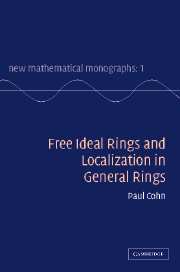Book contents
- Frontmatter
- Contents
- Preface
- Note to the reader
- Terminology, notation and conventions used
- List of special notation
- 0 Generalities on rings and modules
- 1 Principal ideal domains
- 2 Firs, semifirs and the weak algorithm
- 3 Factorization in semifirs
- 4 Rings with a distributive factor lattice
- 5 Modules over firs and semifirs
- 6 Centralizers and subalgebras
- 7 Skew fields of fractions
- Appendix
- Bibliography and author index
- Subject Index
2 - Firs, semifirs and the weak algorithm
Published online by Cambridge University Press: 22 August 2009
- Frontmatter
- Contents
- Preface
- Note to the reader
- Terminology, notation and conventions used
- List of special notation
- 0 Generalities on rings and modules
- 1 Principal ideal domains
- 2 Firs, semifirs and the weak algorithm
- 3 Factorization in semifirs
- 4 Rings with a distributive factor lattice
- 5 Modules over firs and semifirs
- 6 Centralizers and subalgebras
- 7 Skew fields of fractions
- Appendix
- Bibliography and author index
- Subject Index
Summary
After a brief preamble on hereditary rings (Section 2.1), this chapter introduces our main topic, free ideal rings (firs) which form a generalization of principal ideal domains (Section 2.2 and 2.3); frequently they satisfy a weak algorithm relative to a filtration (Section 2.4), which generalizes the division algorithm (relative to a degree-function), to which it reduces in the commutative case. The most important example is the free associative algebra over a field K, characterized as a filtered K-algebra with weak algorithm in Section 2.5, while a useful invariant, the Hilbert series, is described in Section 2.6. Some consequences of the weak algorithm are traced out in Section 2.7 and 2.8; the inverse weak algorithm, using a generalization of the order-function, is used to describe power series rings in Section 2.9 and a transfinite form of the weak algorithm is applied in Section 2.10 to construct one-sided examples. In Section 2.11 a method is described which in many cases allows one to read off from the presentation of a ring whether the n-term weak algorithm holds. This enables one to construct quite naturally n-firs that are not (n + 1)-firs.
- Type
- Chapter
- Information
- Free Ideal Rings and Localization in General Rings , pp. 107 - 185Publisher: Cambridge University PressPrint publication year: 2006



